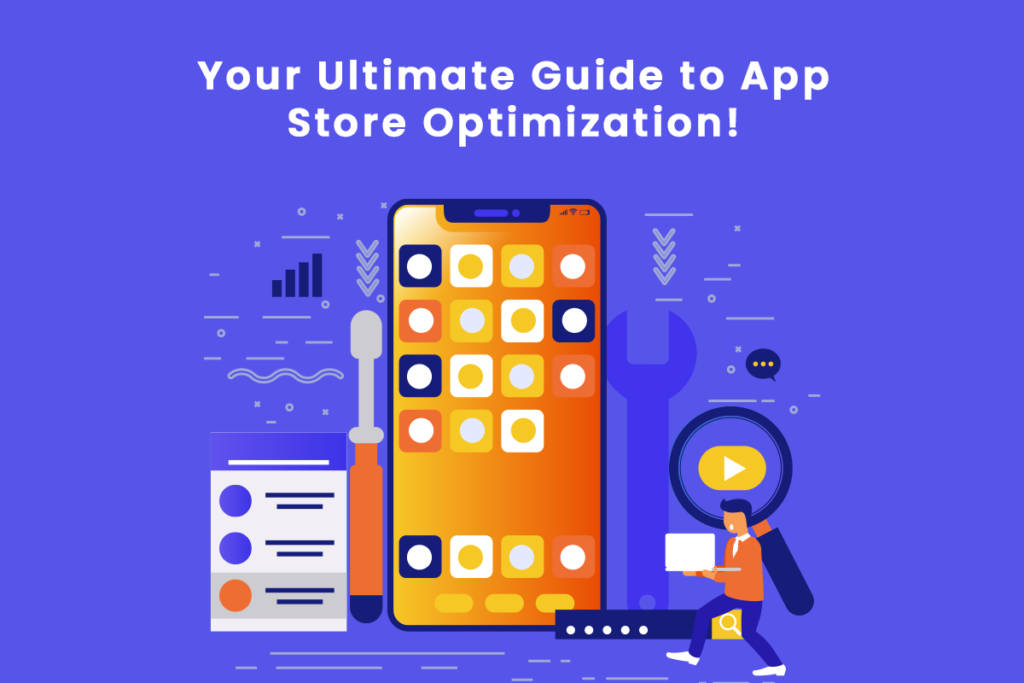
Dominate the App Store: The Ultimate Guide to App Store Optimization
The world of mobile applications has transformed in a quick time, primarily because of higher mobile accessibility. Individuals are now readily utilizing mobile applications for everything from navigation to entertainment.
According to statistics, there are over 2.6 million applications on the Google Play Store and over 2 million different applications on the App Store.
With such a massive audience base, the competitiveness of these mobile applications has also increased. Almost every business uses these applications to give customers or consumers a better experience.
Knowing how to market mobile applications flawlessly plays a vital role in the overall reach and profitability of these applications.
It is where App Store optimization comes into play. App Store Optimization (ASO) provides higher user reach and maximizes the chances of users downloading your applications. With the right ASO strategy, your application ranks higher in the platform’s search bar, driving more users to your application.
However, to utilize ASO, you need an App Store optimization strategy. While this strategy varies a little for Android and iOS users, the primary rules of the approach remain the same. Some of the main items targeted in an ASO strategy include the following:
- Updates
- Ratings and reviews
- Keywords
- Downloads
- App name or title
- App description
Why Does ASO Matter?
App Store Optimization is a staple for developers who want their applications to get the right exposure. A prime reason why many applications don’t reach their true potential is that they aren’t discovered properly.
Since users don’t know about these applications, the apps cannot be downloaded. A wide majority of the users on platforms find applications by browsing.
If your application is not ASO optimized, it will not appear in the search results, reducing the chances of being downloaded. The ASO approach is much more similar to the SEO method for mobile applications.
By improving the ASO of your application, you can easily improve the ranking and discoverability of your mobile applications. It is an all-in-one solution to ensure your applications get the attention they deserve.
ASO for App Store and Google Play Store
Although the basic principle of application optimization is the same for Android and Apple users, several profound differences make these platforms unique in their league. The key factors for the ASO strategies include the following:
- Reviews and ratings
- Keywords
- Installs and engagement
- In-app purchase titles and descriptions
- App URL
- App updates
- App subtitle
- App name
Dominate the App Store: The Ultimate Guide to App Store Optimization
Now that we have discussed the basics of ASO and a simple contrast between optimization for Apple and Android devices—let’s move on. App developers must know the best practices and hacks for App Store Optimization to get a better response. We have outlined some of the best tips to dominate the application platforms, have a look.
- Create a Descriptive App Title
The name of your application is the founding stone of your ASO strategy. It has plenty to do with how users see your applications once it’s released on the respective platform. The right name for your application is the quickest way to show the users what the app does.
It also contributes to better platform rankings. Moreover, adding a keyword or two in the title will improve your application ranking significantly. However, both Apple and Android platforms handle these keywords differently. Therefore, you must know the difference in approach for both. For instance, an App Store title should be:
- Unique
- Keyword rich
- Descriptive
On the other hand, an android application should be a bit different. You only have 30 characters, so you should pick the name carefully. You don’t have to worry about the keywords for Google Play.
- Focus on the App Description
The description of your application is like the landing page of your website. It provides visitors with information about the application after they view the titles.
The app description on the platform is thus a necessary part of any app optimization strategy. It impacts how users see your application and the information you provide.
The best way to write the app description is to consider you as the user. Imagine you know little about an application and rely on the description for quick insight. You need to think as your customer would. It often helps to think in terms of bullet points:
- Why is it worth the price?
- What problem does it solve?
- What does your app do?
- How will it make the buyer’s life easier?
It’s important to be persuasive yet not overdo it at the same time. With a little experimentation, you can find a balance in the app description and connect with a larger audience.
- Use Higher Quality Screenshots
With the availability of so many applications on different platforms, there’s higher competition among app developers to be the best. One of the best ways to showcase your application is to provide in-app screenshots.
They are considered one of the most influential factors in determining how the users see your application. If the screenshots are appealing, chances are, the users will like them more. These screenshots are a sneak peek into the application before the users download it themselves. Therefore, app developers must showcase the most interesting app elements first.
Once you do that, the users will go for the download. However, some app developers try to post fake screenshots in hopes of more downloads. Unfortunately, it only leads to bad reviews and a poor app reputation on the platform.
- Use an App Preview Video
Adding a mobile app preview extends further from basic screenshots within the application. With the inclusion of the latest tech in app development, it’s possible to add app previews on the app platforms. You can add a working application demo in the video preview and ensure users see your app in action.
However, giving users more control over the ads is still important. For instance, no app user wants music blasting out of the video preview. They could be in a formal setting or somewhere quiet, like a library. However, you can add the video preview with a mute button.
The users can check the review without disturbing themselves. If they like the application, they will play the video preview with sound, increasing the chances of a successful app download.
Bear in mind these app previews are usually 30 seconds long, so it’s necessary to feature the best parts of your app. Every second counts, so show the app benefits as well as you can. A great way to do this is to check the competitor’s existing videos. It will give you a good idea of the features your apps should have.
- Choose the Right App Category
To add more structure to the world of mobile app development, platforms have certain app categories. These range from games to utility, depending on what the users want. Placing your application in the right category on both Google Play Store and App Store is vital. It determines your target audience and, ultimately, the number of downloads.
Remember, there’s a chance your mobile application may qualify for multiple categories. There are different approaches you can adopt in cases like these. For starters, you need to pick a mobile app category that best fits your application.
Next, you can check the total number of apps in each category and add your application to the least competitive one. Moreover, the estimated app worth (EAW) shows the top application in each category. Check how well your application competes with these top applications.
Similarly, the platform you add your app to also makes a difference. For instance, the App Store reviews all app submissions before releasing them officially. It could get rejected if you add your application to the wrong category for ASO purposes.
On Google Play, users report violations of category placement for certain apps, forcing the apps to be removed. Most applications reported on the platform include medical applications or those in the sports category.
- Reevaluate your Application Regularly
The mobile app development sector is consistently growing, with app developers adding new applications regularly. As new apps hit the market often, it’s harder for existing applications to compete with the new ones without timely updates.
In some cases, your mobile app rating will not improve despite being launched for several weeks. However, it doesn’t necessarily mean your application is not good enough. Instead, it can mean that your app requires a bit of tweaking.
Identifying your application’s shortcomings is the key to long-term survival in app development. There are various reasons for poor app performance, so it’s important to reassess the important aspects of your application. Here are some possible flaws within your ASO or the app itself.
- The keywords don’t fit right
- Less persuasive app description
- Placement of app in the wrong category
- The application icon is not interesting enough, etc.
When you start optimizing each of these elements, your mobile app ranking with automatically improve. We recommend making changes one at a time and seeing the ranking difference. The changes can typically take one to two weeks to show completely.
You can continue to improve the mobile app from time to time. If you change everything, you won’t know the root problem.
Final Thoughts
Dominating the App Store is one of the biggest challenges you will encounter in the world of mobile app development. The platform is becoming more competitive, with millions of applications online. App developers must keep the App Store Optimization tips and user experiences in mind during development and after release. We recommend following the tips in our ASO guide and making app changes accordingly. It will help you improve app rankings and maximize download rates.
Please feel free to Contact Us for all your app marketing needs.




0